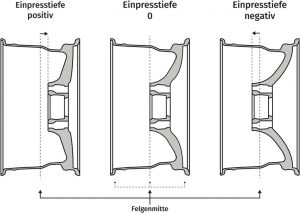Things to Know about Wheel Offset
Things to Know about Wheel Offset
 The wheel offset (abbreviated as ET, from the German term Einpresstiefe) determines the position of the wheel within the wheel well. The ET is thus one of the factors influencing your vehicle’s axle track. This makes it a good place to start if you’re thinking of converting your vehicle to a sportier, wider track. You should be aware, however, that a wider track will only improve road holding to a limited extent. Too wide a track will result in both increased wear and a decline in handling characteristics due to stress on the axles and steering system.
The wheel offset (abbreviated as ET, from the German term Einpresstiefe) determines the position of the wheel within the wheel well. The ET is thus one of the factors influencing your vehicle’s axle track. This makes it a good place to start if you’re thinking of converting your vehicle to a sportier, wider track. You should be aware, however, that a wider track will only improve road holding to a limited extent. Too wide a track will result in both increased wear and a decline in handling characteristics due to stress on the axles and steering system.
The ET is defined as the distance from the centerline of the wheel to the inner contact surface of the wheel flange. The flange is where the wheel rim touches the chassis, where the brake disc and brake drum are mounted. The rim designation contains the ET in millimeters. For example, a wheel rim with the designation 8 J x 18 H2 ET35 LK 5×120 has an ET of 35 millimeters. In addition to ET, the rim designation may also use the term “offset” or the abbreviation IS.
If this information is missing and you do not have the vehicle papers, you can easily calculate the ET. Start by finding the centerline of the wheel rim based on its width. Then, inside the rim, measure the distance between the flange and the outer edge and subtract the resulting number from the value of the centerline. The ET may have a positive or negative value, or even be zero. The latter is the case when the centerline corresponds precisely to where the flange meets the wheel hub. A positive ET indicates that the contact surface of the wheel is shifted outward in relation to the centerline and that the wheel sits lower. A negative ET means that the wheel does not sit as low.
Modifying the ET changes the geometry of the steering axle, which will have an effect on the driving comfort. Manufacturers provide ET values for every vehicle; you can find these in the general operating permit or in a part certificate from a technical inspection association (TÜV). Vehicle owners who do not comply with these values represent a danger on the road and are subject to prosecution.
Too large an ET with the same rim width can lead to the inner wheel edge grinding against the wheel well. This can be avoided with relative ease by using spacer discs and longer screws on all four wheels. If the ET is too small, the outer wheel edge may grind against the wheel well. The only solution to this problem is wider fenders.
In any case, you should always compare the dimensions of new wheel rims with the relevant specifications provided by the vehicle manufacturer. If these values deviate from each other, you will have to seek approval from a TÜV – but this inconvenience will be more than worth it once you are legally on the road with the wheel rims of your dreams!


